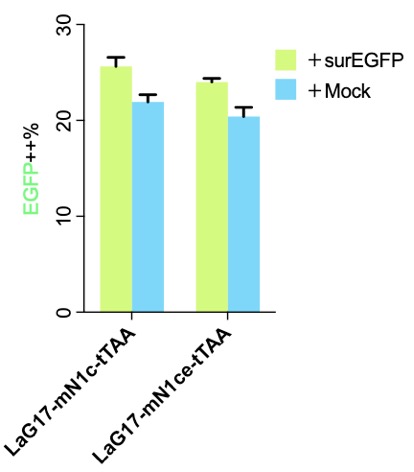Difference between revisions of "Part:BBa K2549021"
| (5 intermediate revisions by the same user not shown) | |||
| Line 17: | Line 17: | ||
It is obvious that αCD19-mN1c-tTAA can be significantly activated by surface-expressed CD19. It also has the highest signal-to-noise ratio among all the SynNotch receptors that we submitted. Besides, it has a lower background activation ratio comparing to others. | It is obvious that αCD19-mN1c-tTAA can be significantly activated by surface-expressed CD19. It also has the highest signal-to-noise ratio among all the SynNotch receptors that we submitted. Besides, it has a lower background activation ratio comparing to others. | ||
| + | LaG16-2-mN1c-GV2 ([[Part:BBa_K2549020]]) and αCD19-mN1c-tTAA ([[Part:BBa_K2549021]]) perform well together, which were used as our common Receptors for ENABLE 16 logic gates. | ||
| + | |||
| + | [[Part:BBa_K2549006]] is exactly as the published version, and results are shown below. Our early results demonstrate three things: (1) SynNotch background activation is very high, which is why we put a lot effect in http://2018.igem.org/Team:Fudan/Optimization ; (3) mN1c might be better than mN1ce, not only shorter but a little higher signal-noise-ratio; (3) LaG17 is NOT a good extracellular antibody for SynNotch. <i>Just use our improved sets, if you want to SynNotch!</i> | ||
| + | |||
| + | [[File:MouseN1ce1c.png|none|333px|thumb|'''Flow cytometry results of the original published SynNotch - not good comparing with ours.''' surEGFP is the surface expressed EGFP, which was used as the antigen. Without antigen (+Mock), the EGFP (Y axis, driven by tTAA released after SynNotch activation) was low, and it went "high" after adding the antigen. More details please visit http://2018.igem.org/Team:Fudan/Results and http://2018.igem.org/Team:Fudan/Optimization . ''We used '''50 ng''' SynNotch plasmids for the experiments here, but '''10 ng''' SynNotch plasmids for the experiments above. The later has reduced background activation and increased signal-noise-ratio.'']] | ||
=====Clinical significance of anti-CD19===== | =====Clinical significance of anti-CD19===== | ||
Latest revision as of 02:15, 18 October 2018
aCD19-mN1c-tTAA
This part is one of our SynNotch receptors, similar to the original published version[1]. It is our favorite. αCD19 (Part:BBa_K2549005) is used as the extracellular sensor module to receive the signal input from surface-expressed CD19. mN1c (Part:BBa_K2549006) is served as the transmembrane core domain of SynNotch, which is evident to have a low basal expression and a high activation efficiency. tTAA (Part:BBa_K2446057) is an improved tetracycline-controlled transactivator[2], which is cleaved after SynNotch activation and drives the expression of the amplifier. Besides, a CD8α signal peptide (Part:BBa_K2549044) and a Myc-tag (Part:BBa_K823036) are added to the N terminal of αCD19 (Part:BBa_K2549005) for membrane targeting and easy determination of surface expression.
Sequence and Features
- 10COMPATIBLE WITH RFC[10]
- 12COMPATIBLE WITH RFC[12]
- 21COMPATIBLE WITH RFC[21]
- 23COMPATIBLE WITH RFC[23]
- 25INCOMPATIBLE WITH RFC[25]Illegal NgoMIV site found at 2493
- 1000INCOMPATIBLE WITH RFC[1000]Illegal BsaI site found at 534
Illegal SapI.rc site found at 1408
Biology
Our characterization

It is obvious that αCD19-mN1c-tTAA can be significantly activated by surface-expressed CD19. It also has the highest signal-to-noise ratio among all the SynNotch receptors that we submitted. Besides, it has a lower background activation ratio comparing to others.
LaG16-2-mN1c-GV2 (Part:BBa_K2549020) and αCD19-mN1c-tTAA (Part:BBa_K2549021) perform well together, which were used as our common Receptors for ENABLE 16 logic gates.
Part:BBa_K2549006 is exactly as the published version, and results are shown below. Our early results demonstrate three things: (1) SynNotch background activation is very high, which is why we put a lot effect in http://2018.igem.org/Team:Fudan/Optimization ; (3) mN1c might be better than mN1ce, not only shorter but a little higher signal-noise-ratio; (3) LaG17 is NOT a good extracellular antibody for SynNotch. Just use our improved sets, if you want to SynNotch!

Clinical significance of anti-CD19
Please refer to our basic Part:BBa_K2549005 for more details.
SynNotch receptors function well in Morsut L et al 2016

Please refer to the original article for more details.
References
- ↑ Engineering Customized Cell Sensing and Response Behaviors Using Synthetic Notch Receptors. Morsut L, Roybal KT, Xiong X, ..., Thomson M, Lim WA. Cell, 2016 Feb;164(4):780-91 PMID: 26830878; DOI: 10.1016/j.cell.2016.01.012
- ↑ Exploring the sequence space for tetracycline-dependent transcriptional activators: novel mutations yield expanded range and sensitivity. Urlinger S, Baron U, Thellmann M, ..., Bujard H, Hillen W. Proc Natl Acad Sci U S A, 2000 Jul;97(14):7963-8 PMID: 10859354

